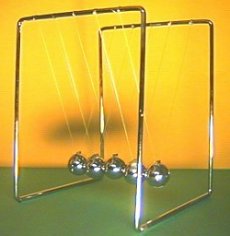1. Collision between two spheres.
Lift a sphere and, keeping the wire in tension, let it fall towards a second one at rest: you will observe that the first sphere blocks upon hitting the second one, which is throw away and gets to the same height the first sphere started from. Falling down, the second sphere hits again the first one, which on its turn swings up to the height it had at the beginning. To understand what happened, we have to start from two preliminary remarks: a) due to the way the spheres are hanged, their motion is guided so that collisions are central; b) the collisions are almost perfectly elastic. Then the laws of physics allows us to write simple relations on the speed of the sphere before and after the collision, by imposing that the kinetic energy and the linear momentum of the entire system are conserved. Without entering into the details of the calculus, the result asserts that in the collision the tow spheres change their speed: the one in motion stops, while the other takes on the same speed the first one had just before the collision.
|
|
2. Collision of three spheres (first case).
Consider the collision of three spheres when one is allowed to swing down towards the others at rest. After the collision, only the last of the row moves up, and gets to the same height the first sphere started from. Since the spheres are at a minimal distance one another, we may interpret this result as the collision happened in sequence. It is then possible to use the example of collision between two spheres to understand what's going on: we just see the change of velocities between the first and the second sphere and then, in exactly the same way, between the second and the third one.
|
|
3. Collision of three spheres (second case).
Lift two spheres on the same side, for instance on the left, and let them fall down towards a third one at rest. We observe that one of the two spheres in motion (the external one) stops, while the other goes on, together with the one initially at rest. Moreover, these two spheres reach the same height from which the original pair was dropped. Also this result can be explained as the collisions happen in sequence: the sphere one on the right hits the one at rest and they change their speed; then the second of the moving spheres hits the central one, now at rest, and throw it away again, with the same speed. Everything happens in so short a time that the spheres seem to move all at once.
|
|
|
Now we could consider the whole game with all of its five spheres, and obtain a wide variety of motions. We will observe strange and delightful trajectories, even more than we could imagine! |



